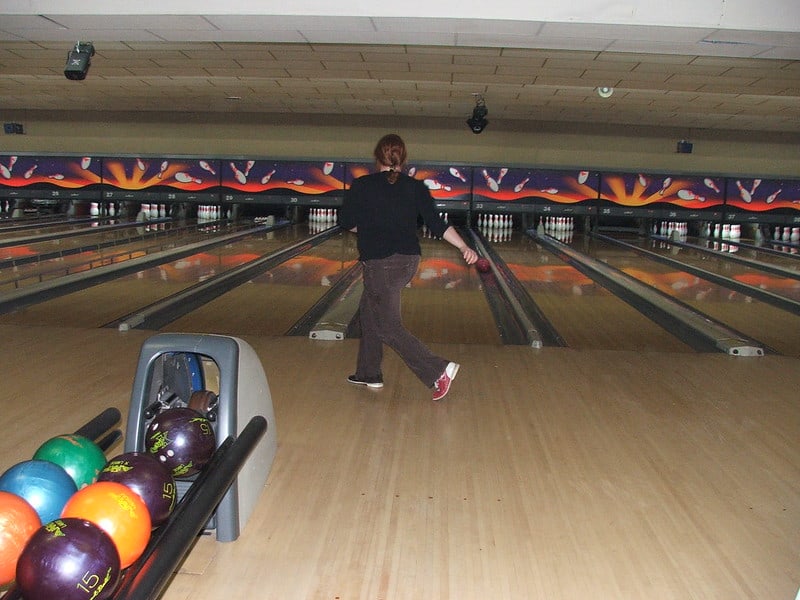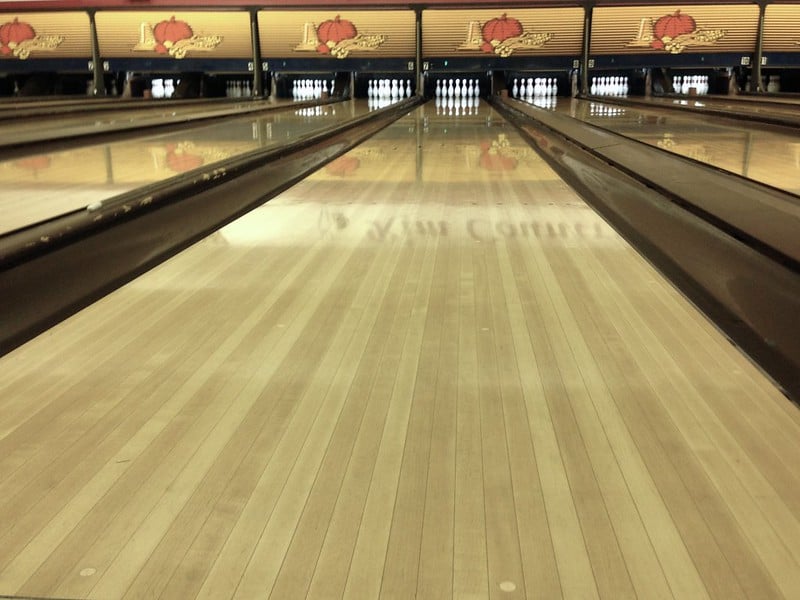When I go bowling and am at the counter paying and getting shoes I admit I sometimes eavesdrop on others’ conversations. When some bowlers come in, instead of the clerks telling them what lane they’ll be at, they sometimes ask which lane or lanes the bowler wants. I wondered, does it matter where they bowl? Aren’t all bowling lanes flat anyway?
Are bowling lanes flat? No. Bowling lanes are not flat. Though they appear to be with the naked eye during the 60ft stretch of bowling lane it may have some dips, curves, waves or slopes. Even though no two lanes are the same and have imperfections they are still legal for league play(if the head organization says they are).
I never knew bowling lanes could have so many different types of typography associated with them. I was amazed. My mind buzzed with more questions
Do Bowling Lanes Have A Slope?
The topography of each bowling lane differs immensely, with each lane being unique. You won’t sit a bowling ball at the top of the lane and it just rolls away, in the same way, if you roll the bowling ball slowly it won’t stop at one point and begin rolling either back to you to the left or right.
When bowling first came to America lanes were made from clay. So you can imagine how difficult it would have been to make sure that not only that the lanes were even, but also that they had no slope. It’s not noted when wood became the choice for bowling lanes, but the job of making the lanes flat became easier.
A few times a year a company would come in and check the lanes with various devices that are mostly unknown today. Many believe they just used a simple level. The lanes would be checked and simply sanded down the best they could be and re-oiled.
Since this was a time consuming and expensive ordeal, costing bowling alleys much needed money to operate, this was apart of the reason synthetic bowling lanes came about.
Another reason for synthetic bowling lanes is the cost and environmental impact of real wood. The Kegel LaneMapper™ is used to do the task of checking lanes now for imperfections.
Every other year or so bowling lanes are to be checked for imperfections like slopes, dips, weaving, etc. With the newer synthetic lanes in bowling alleys now, this doesn’t happen as it should.

Bowling alley owners don’t get this done as often due to a number of reasons. One main reason is that their bowling alleys either don’t host tournaments, they just can’t afford the service or to shut down for a few days to have the lanes reflattened would put them out of business.
Reflattening bowling lanes used to take a lot of time and the cost was quite high. Now the cost is still not cheap but it still does take a bit of time. And for a small bowling alley that doesn’t bring in much money, this is normally something that gets left by the waist side.
Imagine your home is on a slope, or not level. It wouldn’t be advisable to live in a home-like that depending on the degree of the slope, but it could be done. In bowling, just like with homes, a slope could be present but unless it’s visibly noticeable it would need to be checked periodically.
How Long Are Bowling Lanes?
Bowling lanes are 60 feet long and 42 inches wide. The length of the bowling lane is measured from the foul line to the front or headpin. This is set by the United States Bowling Congress, the authority of ten pin bowling in the United States.
Knowing how long the bowling lane won’t help your bowling game at all. It doesn’t even really matter if you know how long or wide it is. When you first start taking bowling seriously your main focus is just knocking all of the pins down. There are other factors of a bowling lane other than its length and width that can help you.
- There are 40 individual boards that make up a bowling lane 42 inches
- The arrows on the bowling lane are 15 feet from the foul line
- There are 2 sets of approach dots, the first set is 12 feet from the foul line and the second set is 15 feet from the foul line
Many bowlers will use one or more of these indicators to line up their shots. Learning how to hook your bowling ball means nothing if you don’t know where to throw it. You could throw a mean hook…that always ends up in the gutter.
What’s The Purpose of Gutters in Bowling Lanes?
When you first started bowling, you probably threw quite a few gutter balls. Even after you’ve been bowling for years, you still might throw a ball or two into the gutter.

Gutter balls are so frustrating that bumpers are put up so children and people who need assistance don’t feel discouraged while bowling. Nobody would want to bowl if no matter how hard they tried they always threw gutter balls.
Most children will eventually outgrow this, but some won’t, so bumpers are there to help keep the game fun and exciting.
The entire width of a bowling lane, from edge to edge of the gutters is 3 feet 6 inches. With the gutters being 9.25 inches wide themselves and 1 ⅞ inches deep. Gutters sit outside the bowling lane and if your ball falls into one it means you fouled out that frame. Like in baseball except if you get 1 strike you get 2 more swings. Well, not in bowling.
To avoid the dreaded gutter ball it helps to learn to aim before you throw. This will take some practice. You could learn a mean hook but if you’re off by even a little…BAM!…right in the gutter.
Could you imagine bowling without the thrill/fear of gutter balls? How much fun could that be? Knowing that even if you didn’t try you could still possibly get a strike. You’d get so bored you’d never want to play.
Nobody wants to play something easy…it’s not fun. When was the last time you sat down with your buddies and played connect four? Or apples to apples? I bet you were a kid right?
Those games were fun when you were young because they had a challenge to them…but not so much now that you’re an adult. If the basketball hoop was right at your waist and all you had to do was drop the ball…would you want to play?

Bowling needs gutters to make the game fun, exciting and interesting. Place a few innocent bets with your friends next time you go that you won’t get a gutter ball, or that maybe they will…makes the game more enjoyable.
Related Questions
What are bowling alley lanes made of?
Many older bowling lanes are made of wood. The wood is maple and pine. New lanes are made from a reinforced synthetic composite material that is made to look like wood. Bowling lanes made from real wood need to be periodically flattened due to it wearing away due to use, synthetic lanes do not.
How can you tell if a bowling lane is dry?
To find out if your bowling lane is dry, simply take a house bowling ball and give it a good throw down the lane. Since house bowling balls are made of plastic they skid down lanes with oil. So if the lane is dry the plastic bowling ball will grab the lane and spin.
What kind of oil is used on bowling lanes?
There are many types of oil used on bowling lanes. The most common is mineral oil. Oil is needed to protect the bowling lane and your ball. Without it, your bowling ball would burn the lane and explode in the gutter.

